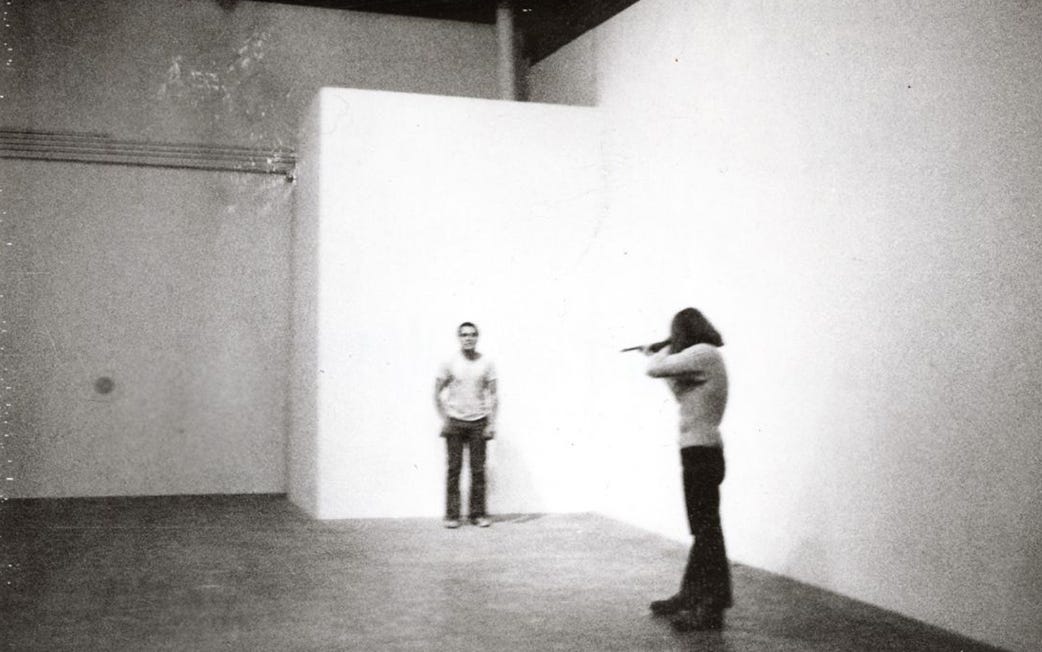Straight Shooting Art
The sort where you don't want to look but you can't look away
In 1971 the American artist Chris Burden (1946-2015) made a performance piece called SHOOT. It’s one of those artworks that has always stayed with me and every so often comes into my mind. I’ve been thinking about it a lot recently. In this artwork he arranged to have himself shot in the arm with a .22 calibre rifle at close range.
Now, you might think that’s going quite far in the name of art - putting your life at risk, or at least sustaining what could be a serious injury. And you might also ask why anyone would do that? What’s the point? Was it for the shock value?
The point for Burden was that he wanted to explore through his work what the artist could physically endure and what we, the audience, could endure to watch.
Burden is not well known in the Art Halls of Fame, although he should be. He made audacious and original art, particularly in his early career back in the 70s. In those days he was a performance artist, which is a type of art where the artist uses their body as the medium of the artwork. The performance is often captured on film or in photographs to record it for posterity.
Burden captured SHOOT on film, although the quality isn’t great and it’s quite grainy. I find it quite shocking and gripping [warning there’s some blood]:
There’s something compelling about watching it. You don’t want to look but you can’t look away. And that’s the point. In my opinion Burden was an extraordinary artist, and SHOOT was a brilliant concept for an artwork.
The media environment that we live in desensitises us to shocking real life events that ordinarily we would find very difficult to look at and deal with had we been caught up in them ourselves. We can distance ourselves emotionally from the images we see because we are consumers rather than participants.
Burden’s performance was a real event, but it is also an artwork. We are primed to contemplate art and to think about what its meanings could be in a way that we don’t with documentary images from the news media.
Burden performed SHOOT at a time when the American public had become numb to seeing the endless news reports of the death and destruction in the Vietnam war. So he might have meant it as a comment on the emotional disconnection that comes from consuming news media. He might have meant it as a critique of the pointlessness of the Vietnam War and the American public’s disinterest in the issues they were fighting about.
In a way it doesn’t really matter what his intention was because if one of the purposes of art is to make us think, then this piece has an enduring power to it. Burden made it in a different time and place, more than 50 years ago, but it immediately brings me to events happening in my world and how we process them.
It definitely makes me think of violence, guns and war. And particularly the war in Ukraine at the moment. After the initial shock of the start of the war, one might argue that we have become increasingly numb to what’s going on there. SHOOT makes me think about how we’ve got a choice to look away. But the people in Ukraine fighting for their freedom don’t have that choice. The threat of being killed or injured is their daily reality.
SHOOT is more than just spectacle. It’s more than passive consumption of imagery. It represents difficult ideas that make us feel uneasy. It generates an uncomfortable response in us, and that’s why I think it’s such a powerful work of art.
I’d love to know your thoughts on it. What does it make you think of? Do you think this kind of art is interesting?
If you’re interested in learning more about Chris Burden here are a couple of links:
A short documentary from New York Times about SHOOT with Chris Burden and the marksman discussing the work
A film documentary about Burden’s career as an artist



For me, it's the still frame of the moment before the shooting that got me. It connects with photographic records of executions, which often looking like 'snapshots' (!) taken casually or surreptitiously. Plus Burden's movement after the instant he was shot; plus the mix of caring and legalism of a report having to be made.
In general classic performance artists of these years put their bodies or parts of their bodies 'in harm's way' and there were often real consequences as we see in Burden's piece. In this sense, performance of this type were 'heroic' if we define heroism as putting oneself in harms way for some extraneous reason, (such as making an art piece). One could say perhaps that they are in the tradition of 'mock-heroic' even. See also Stuart Brisley, Maria Abramovitch, etc
Flip. I could hardly watch this. But as you say Victoria, you can't look away! It made me think of a book I'm reading about WWII spies and how they were summarily executed by the Nazis if they were caught.